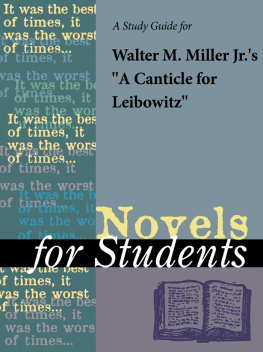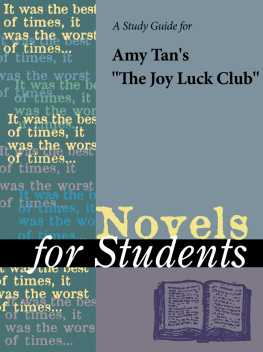TABLE OF CONTENTS
Guide
Novels for Students, Volume 44
Project Editor: Sara Constantakis
Rights Acquisition and Management: Sheila Spencer
Composition: Evi Abou-El-Seoud
Manufacturing: Rhonda Dover
Imaging: John Watkins
Product Design: Pamela A. E. Galbreath, Jennifer Wahi
Digital Content Production: Allie Semperger
Product Manager: Meggin Condino
2014 Gale, Cengage Learning
ALL RIGHTS RESERVED. No part of this work covered by the copyright herein may be reproduced, transmitted, stored, or used in any form or by any means graphic, electronic, or mechanical, including but not limited to photocopying, recording, scanning, digitizing, taping, Web distribution, information networks, or information storage and retrieval systems, except as permitted under Section 107 or 108 of the 1976 United States Copyright Act, without the prior written permission of the publisher.
Since this page cannot legibly accommodate all copyright notices, the acknowledgments constitute an extension of the copyright notice.
For product information and technology assistance, contact us at Gale Customer Support, 1-800-877-4253.
For permission to use material from this text or product, submit all requests online at www.cengage.com/permissions.
Further permissions questions can be emailed to permissionrequest@cengage.com
While every effort has been made to ensure the reliability of the information presented in this publication, Gale, a part of Cengage Learning, does not guarantee the accuracy of the data contained herein. Gale accepts no payment for listing; and inclusion in the publication of any organization, agency, institution, publication, service, or individual does not imply endorsement of the editors or publisher. Errors brought to the attention of the publisher and verified to the satisfaction of the publisher will be corrected in future editions.
Gale
27500 Drake Rd.
Farmington Hills, MI, 48331-3535
ISBN-13: 978-1-4144-9487-6
ISBN-10: 1-4144-9487-4
ISSN 1094-3552
This title is also available as an e-book.
ISBN-13: 978-1-4144-9273-5
ISBN-10: 1-4144-9273-1
Contact your Gale, a part of Cengage Learning sales representative for ordering information.
Printed in Mexico
1 2 3 4 5 6 7 17 16 15 14 13
A Canticle for Leibowitz
Walter M. Miller Jr.
1959
Introduction
Published in 1959 at the height of the Cold War, Walter M. Miller Jr.'s A Canticle for Leibowitz is acknowledged as perhaps the greatest novel to deal with the potential disaster of a nuclear war. At the time of its publication, a war between the Soviet Union and the United States seemed almost inevitable and would have resulted in something between the destruction of technological civilization and the extermination of all life on earth. Miller takes as his starting point the commonplace that a nuclear war would, at a minimum, plunge humanity into a new dark ages. He develops this theme literally, telling his story as the history of a Catholic monastery in the American Southwest founded by Isaac Leibowitz, one of the few engineers left, and dedicated to preserving the few scraps of technical information that survived the war that the monks refer to as the Flame Deluge. In Miller's vision, history repeats itself exactly with a new Renaissance, fueled in part by the work of the monastery of St. Leibowitz, and a new Cold War, and finally another and more devastating nuclear war. The Order of Leibowitz finally renews its role of scientific preservation by helping to transport human civilization to an interstellar colony. Miller also deals presciently with the problems of abortion and euthanasia that have come to the fore of American culture in the twenty-first century, a debate that touched Miller personally as he struggled with suicidal depression from what today would be called post-traumatic stress disorder following his service as a bomber crewman in World War II. In this way Miller, like any great writer, transcends the limits of genre. Contrary to expectation, A Canticle for Leibowitz (like Stanley Kubrick's film Dr. Strangelove, or How I Learned to Stop Worrying and Love the Bomb, perhaps the greatest artistic treatment of nuclear war in any medium) is not a tragedy but a comedy. Perhaps there is no other way to approach the insanity of its subject matter, which is ultimately the suicide of the entire human race.
Author Biography
Walter M. Miller Jr. was born in New Smyrna Beach, Florida, on January 23, 1923. His father was a railroad employee. During World War II, Miller served as a radioman and tail-gunner in the Mediterranean theater and flew fifty-three combat missions on B-25 bombers. He was especially affected by a mission in 1944 to bomb Monte Casino, the site of the oldest active monastery in Western Europe but also a key mountaintop position for the German Gustav Line. Attacking the historic landmark was controversial, and even the Nazis agreed to a truce to allow time to evacuate its art treasures and manuscripts. After the war, Miller studied engineering at the University of Texas, but he did not complete a degree before taking work with a series of rail lines. He seems to have worked at this career throughout his adult life. In 1945 he married Anne Louise Becker, with whom he had four children. He converted to Catholicism in 1947.
Recuperating from a car accident, Miller began to write and publish short stories, eventually specializing in the science fiction genre, and also produced scripts for the Captain Video television show. In 1950, he had an affair with the science fiction author Judith Merril (who had published Shadow on the Hearth in 1950, probably the first novel based on the aftermath of a nuclear war), though he later reconciled with his wife. In 1955, Miller won the Hugo Award (the most prestigious literary award in the science fiction genre) for his short novel The Darfsteller, which concerns the replacement in mass culture of human artistic creativity by computer-generated entertainment. Between 1955 and 1957, Miller published three more short novels in The Magazine of Fantasy and Science Fiction, which he reworked into his major work, A Canticle for Leibowitz, in 1959. While he was revising the first section, which takes place in the bombed-out ruins of an American city, he realized that he was working through his mental anguish over his role in the bombing of Monte Casino. A Canticle for Leibowitz also won the Hugo Award in 1960. It also became a best seller, crossing over to mainstream readers, and it has remained in print since its initial publication.
Miller quickly became disenchanted with his celebrity and retreated from the science fiction and literary worlds, publishing nothing else during his lifetime (though he did edit Beyond Armageddon, an anthology of postnuclear war stories, in 1985). He spent much of his later years writing Saint Leibowitz and the Wild Horse Woman. But following years of depression, Miller killed himself on January 9, 1996, shortly after the death of his wife, leaving the work unfinished. This novel takes place in the same continuity as A Canticle for Leibowitz





















